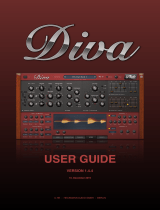
14
LEFT-HAND KEYBOARD PANEL (Continued)
GLIDE
Glide allows the pitch to change in a smooth, continuous manner as you transition from note to note,
rather than instantly stepping to the new pitch.
GLIDE SWITCH
Located on the Left-Hand Keyboard panel, this switch turns the Glide effect on and off.
GLIDE KNOB
Located on the CONTROLLERS panel, the GLIDE knob determines the amount of time needed to
transition from one note to the next.
DECAY SWITCH
When the DECAY switch is ON, the last note played will continue to sound as it fades and the Filter Cutoff
Frequency will lower at the rate set using the DECAY TIME knobs in the MODIFIERS section. (Page 16).
MIXER & NOISE
The MIXER sets the levels of all ve of the Minimoog Model D audio sources—3 Oscillators, Noise
Generator, and External Audio Input. The combined output of the Mixer next passes through the Filter
and nally arrives at the audio output. In addition to a dedicated Volume knob, each audio source also
includes an On/Off switch. These switches allow any source to be quickly removed from the mix while
preserving their VOLUME knob position, and can also be useful when setting the tuning of each Oscillator.
The Oscillators are somewhat self-explanatory in regard to the Mixer. The External Input Volume and the
Noise Generator require some extra explanation.
EXTERNAL INPUT VOLUME
An external audio source can be introduced to the Minimoog Model
D using the EXT. INPUT SIGNAL jack located on the Top Patch
Panel. The Volume of the external signal is controlled using this knob.
If no cable is connected to the EXT. INPUT SIGNAL jack, the
main audio output of the Minimoog Model D is attenuated slightly
and then normalled to the External Input signal path. In this case,
the Main Output signal is sent back to the input of the mixer. By
increasing the External Input volume far enough, the Mixer can
overload, introducing varying levels of overdrive or distortion. When
this occurs, the Overload indicator lamp will light. In this case, the
External Input Volume control is POST Main Output volume. This
means that the MAIN OUTPUT VOLUME knob will affect the amount
of overload in addition to the EXTERNAL INPUT VOLUME knob.
CRITICAL NOTE: With no cable connected to the EXT. INPUT SIGNAL jack, and the EXTERNAL INPUT
VOLUME and MAIN OUTPUT VOLUME controls turned all the way up, it is possible to overload the mixer to
the point that only one sound is heard and different pitches do not sound. This will not damage the instrument.
NOISE
Noise can be a very desirable sound source—either alone, or mixed in with other sources. It can be used
to create anything from a rocket launch to the subtle breath of a ute sound. In addition to the NOISE
VOLUME knob, there is a switch for selecting either WHITE or PINK noise. White Noise contains all
audible frequencies at equal amplitude levels, much like white light. Pink Noise contains equal energy in
each band of the audio spectrum, and is perceived as having more low-frequency components. If you
think of White Noise as TV static, consider Pink Noise more as a waterfall pounding the rocks below.





















